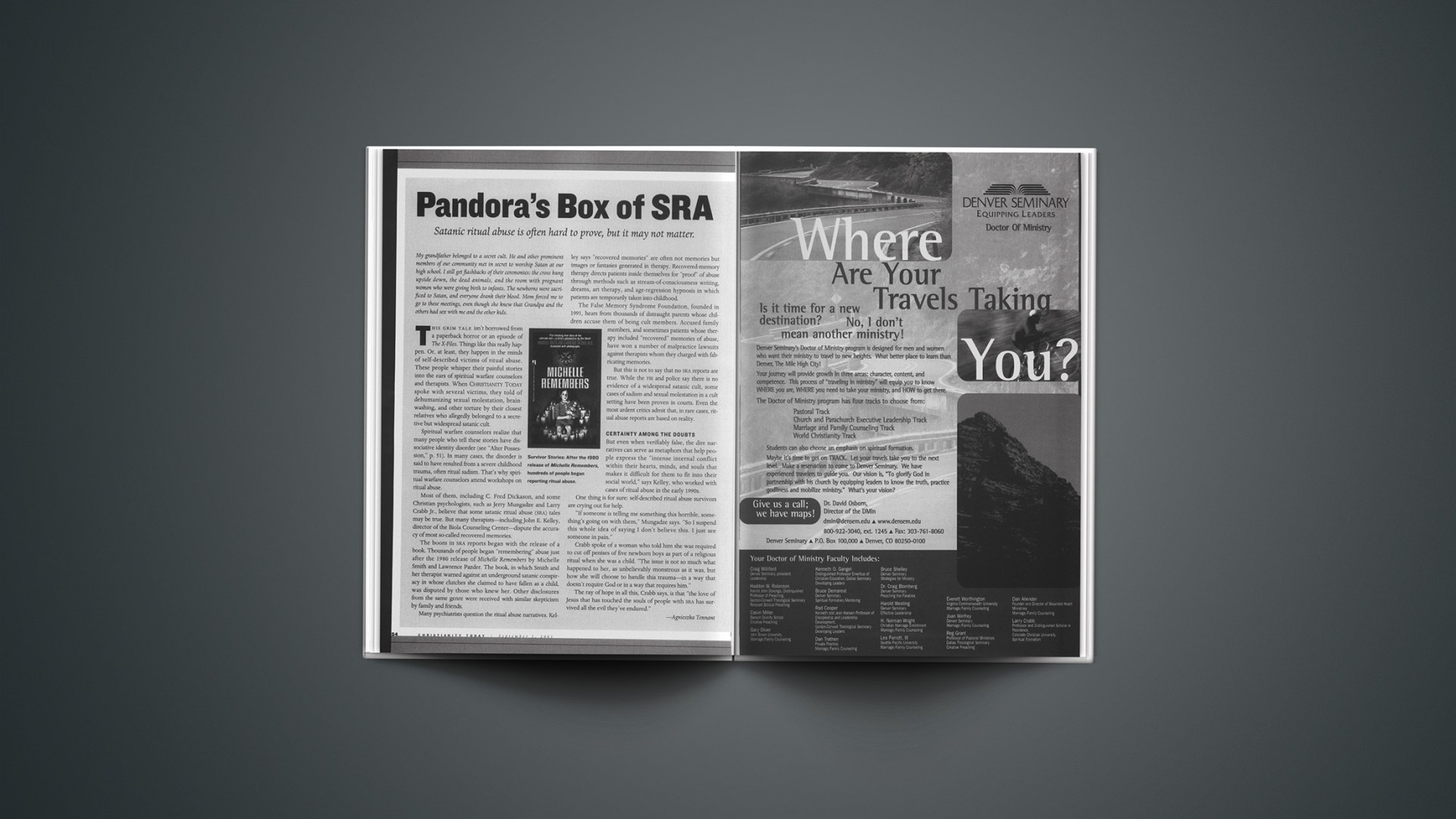My grandfather belonged to a secret cult. He and other prominent members of our community met in secret to worship Satan at our high school. I still get flashbacks of their ceremonies: the cross hung upside down, the dead animals, and the room with pregnant women who were giving birth to infants. The newborns were sacrificed to Satan, and everyone drank their blood. Mom forced me to go to these meetings, even though she knew that Grandpa and the others had sex with me and the other kids.
This grim tale isn’t borrowed from a paperback horror or an episode of The X-Files. Things like this really happen. Or, at least, they happen in the minds of self-described victims of ritual abuse. These people whisper their painful stories into the ears of spiritual warfare counselors and therapists. When Christianity Today spoke with several victims, they told of dehumanizing sexual molestation, brainwashing, and other torture by their closest relatives who allegedly belonged to a secretive but widespread satanic cult.
Spiritual warfare counselors realize that many people who tell these stories have dissociative identity disorder (see “Alter Possession,” p. 51). In many cases, the disorder is said to have resulted from a severe childhood trauma, often ritual sadism. That’s why spiritual warfare counselors attend workshops on ritual abuse.
Most of them, including C. Fred Dickason, and some Christian psychologists, such as Jerry Mungadze and Larry Crabb Jr., believe that some satanic ritual abuse (SRA) tales may be true. But many therapists—including John E. Kelley, director of the Biola Counseling Center—dispute the accuracy of most so-called recovered memories.
The boom in SRA reports began with the release of a book. Thousands of people began “remembering” abuse just after the 1980 release of Michelle Remembers by Michelle Smith and Lawrence Pazder. The book, in which Smith and her therapist warned against an underground satanic conspiracy in whose clutches she claimed to have fallen as a child, was disputed by those who knew her. Other disclosures from the same genre were received with similar skepticism by family and friends.
Many psychiatrists question the ritual abuse narratives. Kelley says “recovered memories” are often not memories but images or fantasies generated in therapy. Recovered-memory therapy directs patients inside themselves for “proof” of abuse through methods such as stream-of-consciousness writing, dreams, art therapy, and age-regression hypnosis in which patients are temporarily taken into childhood.
The False Memory Syndrome Foundation, founded in 1991, hears from thousands of distraught parents whose children accuse them of being cult members. Accused family members, and sometimes patients whose therapy included “recovered” memories of abuse, have won a number of malpractice lawsuits against therapists whom they charged with fabricating memories.
But this is not to say that no SRA reports are true. While the fbi and police say there is no evidence of a widespread satanic cult, some cases of sadism and sexual molestation in a cult setting have been proven in courts. Even the most ardent critics admit that, in rare cases, ritual abuse reports are based on reality.
Certainty Among the Doubts
But even when verifiably false, the dire narratives can serve as metaphors that help people express the “intense internal conflict within their hearts, minds, and souls that makes it difficult for them to fit into their social world,” says Kelley, who worked with cases of ritual abuse in the early 1990s.One thing is for sure: self-described ritual abuse survivors are crying out for help.
“If someone is telling me something this horrible, something’s going on with them,” Mungadze says. “So I suspend this whole idea of saying I don’t believe this. I just see someone in pain.”
Crabb spoke of a woman who told him she was required to cut off penises of five newborn boys as part of a religious ritual when she was a child. “The issue is not so much what happened to her, as unbelievably monstrous as it was, but how she will choose to handle this trauma—in a way that doesn’t require God or in a way that requires him.”
The ray of hope in all this, Crabb says, is that “the love of Jesus that has touched the souls of people with SRA has survived all the evil they’ve endured.”
Copyright © 2001 Christianity Today. Click for reprint information.
Related Elsewhere
See today’s related articles on deliverance:Possessed or Obsessed? | Many Christians say they are in need of deliverance but some may be giving demons more than their due.
Exorcism Therapy | An interview with Michael W. Cuneo, author of American Exorcism: Expelling Demons in the Land of Plenty
Alter Possession | Some “demons” are better left unexorcised.
Exorcism 101 | What we can learn from the way Jesus cast out demons?
Learning English From MTV | Inside Agnieszka Tennant’s article on deliverance ministries.
The Apologetics Index and ReligiousTolerance.org have great resources on SRA.
Although out of print, Michelle Remembers is available used at Amazon.com.
The False Memory Syndrome Foundation site includes background on the foundation and a newsletter.
The False Memory Syndrome Facts site collects scientific analysis, media coverage, and lists various organizations.
A 1997 paper published by the American Academy of Experts in Traumatic Stress, Inc., examined the sociological views of satanic ritual abuse.
“Creating Repressed Memories: A Case Example” by Terrence W. Campbell is posted on the site of the Institute for Psychological Therapies. Another IPT article asks, “Why believe that for which there is no good evidence?“
Christian group Answers in Action has a collection of information on SRA that includes facts and a Journal of Psychology and Theology article on why Christians fall for lies.
Breaking Free is a SRA Survivor’s group that says satanic ritual abuse “is very real indeed, although many people choose to believe that it is not.”










